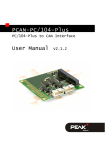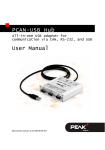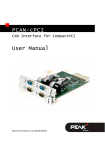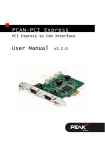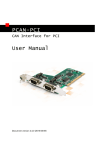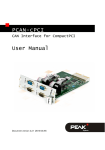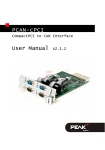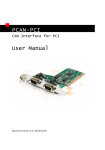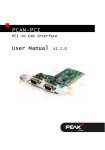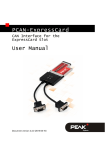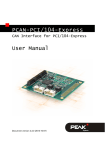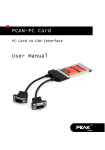Download PCAN-PC/104-Plus - User Manual - PEAK
Transcript
PCAN-PC/104-Plus CAN Interface for PC/104-Plus User Manual Document version 2.3.0 (2015-06-09) PCAN-PC/104-Plus – User Manual Products taken into account Product Name Model Part Number PCAN-PC/104-Plus Single Channel One CAN channel IPEH-002094 PCAN-PC/104-Plus Dual Channel Two CAN channels IPEH-002095 PCAN-PC/104-Plus Single Channel opto-decoupled One CAN channel, galvanic isolation for CAN connection IPEH-002096 PCAN-PC/104-Plus Dual Channel opto-decoupled Two CAN channels, galvanic isolation for CAN connections IPEH-002097 The cover picture shows the product PCAN-PC/104-Plus Dual Channel optodecoupled. Other product versions have an identical form factor but vary in equipment. On request you can get the product versions with stack-through connectors for the ISA bus. CANopen® and CiA® are registered community trade marks of CAN in Automation e.v. All other product names mentioned in this manual may be the trademarks or registered trademarks of their respective companies. They are not explicitly marked by “™” and “®”. Copyright © 2015 PEAK-System Technik GmbH Duplication (copying, printing, or other forms) and the electronic distribution of this document is only allowed with explicit permission of PEAK-System Technik GmbH. PEAK-System Technik GmbH reserves the right to change technical data without prior announcement. The general business conditions and the regulations of the license agreement apply. All rights are reserved. PEAK-System Technik GmbH Otto-Roehm-Strasse 69 64293 Darmstadt Germany Phone: +49 (0)6151 8173-20 Fax: +49 (0)6151 8173-29 www.peak-system.com [email protected] Document version 2.3.0 (2015-06-09) 2 PCAN-PC/104-Plus – User Manual Contents 1 Introduction 1.1 Properties at a Glance 1.2 System Requirements 1.3 Scope of Supply 5 5 6 7 2 Installing and Configuring the Software and the Card 8 2.1 Configuring the Card 8 2.1.1 Setting the Position in the PC/104 Stack 8 2.2 Installing the Software and the Card 10 2.3 Notes for the ISA Bus Stack-through Connection 12 3 Connecting the CAN Bus 3.1 D-Sub connector 3.1.1 Slot Bracket with D-Sub Connectors 3.2 Supplying External Devices via the CAN Connector 3.3 Cabling 3.3.1 Termination 3.3.2 Example of a Connection 3.3.3 Maximum Bus Length 13 13 15 4 Software and API 4.1 Monitor Software PCAN-View 4.1.1 Receive/Transmit Tab 4.1.2 Trace Tab 4.1.3 PCAN-PC/104-Plus Tab 4.1.4 Status Bar 4.2 Linking Own Programs with PCAN-Basic 4.2.1 Features of PCAN-Basic 4.2.2 Principle Description of the API 20 20 23 25 26 26 27 28 29 3 16 18 18 18 19 PCAN-PC/104-Plus – User Manual 4.2.3 5 Notes about the License Technical Specifications 30 31 Appendix A CE Certificate 33 Appendix B Dimension Drawing 34 Appendix C Quick Reference 35 4 PCAN-PC/104-Plus – User Manual 1 Introduction The PCAN-PC/104-Plus card enables the connection of one or two CAN networks to a PC/104-Plus system. Up to four cards can be operated, with each piggy-backing off the next. The CAN bus is connected using a 9-pin D-Sub plug on the slot bracket supplied. The card is available as a single or dual-channel version. The optodecoupled versions also guarantee galvanic isolation of up to 500 Volts between the PC and the CAN sides. Device drivers and programming interfaces exist for different operating systems, so programs can easily access a connected CAN bus. Tip: At the end of this manual (Appendix C) you can find a Quick Reference with brief information about the installation and operation of the PCAN-PC/104-Plus card. 1.1 Properties at a Glance Form factor PC/104 Use of the 120-pin connection for the PCI bus Up to four cards can be used in one system Compliant with CAN specifications 2.0A (11-bit ID) and 2.0B (29-bit ID) Bit rates from 5 kbit/s up to 1 Mbit/s Connection to CAN bus through D-Sub slot bracket, 9-pin (in accordance with CiA® 102) NXP SJA1000 CAN controller, 16 MHz clock frequency NXP PCA82C251 CAN transceiver 5 PCAN-PC/104-Plus – User Manual 5-Volt supply to the CAN connection can be connected through a solder jumper, e.g. for external bus converters 1 or 2 High-speed CAN channels (ISO 11898-2) Galvanic isolation on the CAN connection up to 500 V (only opto-decoupled versions), separate for each CAN channel PC/104-ISA stack-through connector Extended operating temperature range from -40 to 85 °C (-40 to 185 °F) Note: This manual describes the use of the PCAN-PC/104-Plus card with Windows. You can find device drivers for Linux and the corresponding application information on the provided DVD in the directory branch Develop and on our website under www.peak-system.com/linux. 1.2 System Requirements PC/104 stack with PCI-Bus (according to the specification PC/104Plus) Operating system Windows 8.1, 7, Vista (32/64-bit) or Windows CE 6.x (x86 and ARMv4 processor support) or Linux (32/64-bit) 6 PCAN-PC/104-Plus – User Manual 1.3 Scope of Supply PCAN-PC/104-Plus card Slot bracket with D-Sub connectors for the CAN bus Device drivers for Windows 8.1, 7, Vista and Linux (32/64-bit) Device driver for Windows CE 6.x (x86 and ARMv4 processor support) PCAN-View CAN monitor for Windows 8.1, 7, Vista (32/64-bit) PCAN-Basic programming interface consisting of an interface DLL, examples, and header files for all common programming languages Manual in PDF format 7 PCAN-PC/104-Plus – User Manual 2 Installing and Configuring the Software and the Card This chapter covers the configuration and the software setup for the PCAN-PC/104-Plus card under Windows and the installation of the card in the PC/104 stack. Note: Under Windows the PCAN-PC/104-Plus card is run as a PCI card. 2.1 Configuring the Card Before installing the PCAN-PC/104-Plus card into a PC/104 stack, you may have to configure it using jumpers on the PCB. Attention! Electrostatic discharge (ESD) can damage or destroy components on the PCAN-PC/104-Plus card. Take precautions to avoid ESD when handling the card. 2.1.1 Setting the Position in the PC/104 Stack For communication with the host the PCAN-PC/104-Plus card uses the PCI interface where specific relations between the lengths of the signal lines must be met. Different line lengths result from different positions of a PC/104-Plus card in a PC/104 stack. Therefore the PCAN-PC/104-Plus card must be adjusted to a specific position in the stack by setting the appropriate jumpers. The spatial distance to the host results in the index for the assignment of the jumpers. 8 PCAN-PC/104-Plus – User Manual Figure 1: Position of the jumpers J7, J8, J9 on the PCAN-PC/104-Plus card Position in the PC/104 stack Jumper Signal J7 ID Select J8 Clock Select 0 1 2 3 J9 Interrupt Select A B C D 1 2 3 4 0 1 2 3 9 PCAN-PC/104-Plus – User Manual 2.2 Installing the Software and the Card Setup the driver before installing the PCAN-PC/104-Plus card in the PC/104 stack. Do the following to setup the driver: 1. Insert the supplied DVD into the appropriate drive of the computer. Usually a navigation program appears a few moments later. If not, start the file Intro.exe from the root directory of the DVD. 2. Select in the main menu Drivers, and then click on Install now. 3. Confirm the message of the User Account Control in relation to "Installer Database of PEAK Drivers". The setup program for the driver is started. 4. Follow the instructions of the program. 10 PCAN-PC/104-Plus – User Manual Do the following to install the PCAN-PC/104-Plus card into the PC/104 stack: Attention! Electrostatic discharge (ESD) can damage or destroy components on the PCAN-PC/104-Plus card. Take precautions to avoid ESD when handling the card. 1. Plug a cable from the slot bracket to a 10-pin socket for each CAN connection. Figure 2: Position of the sockets for the CAN connection, J4 for CAN channel 1 (upper position), J5 for CAN channel 2 (lower position, Dual Channel versions only) 2. Shut down the computer. 3. Disconnect the computer from the power supply. 11 PCAN-PC/104-Plus – User Manual 4. Insert the card into the PC/104 stack at the position configured before (1 to 4). 5. Reconnect the power supply of the computer. Do the following to complete the initialization: 1. Turn on the computer and start Windows. Make sure that you are logged in as user with administrator privileges. Windows notifies that new hardware has been detected. The drivers are found and installed by Windows. After the driver has been successfully set up you can find the entry “PCAN-PCI” in the branch “CAN-Hardware” of the Windows Device Manager. 2.3 Notes for the ISA Bus Stack-through Connection If you want to use additional modules in the PC/104 stack being connected via the ISA bus, the connections J1 and J2 must be equipped with stack-through connectors. On request you get a respective version of the PCAN-PC/104-Plus card. Taking the host as point of view, PC/104 modules with ISA bus must be plugged onto the stack behind any module with PCI bus. The signals of the ISA bus are connected through and not used by the PCAN-PC/104-Plus card. 12 PCAN-PC/104-Plus – User Manual 3 3.1 Connecting the CAN Bus D-Sub connector A High-speed CAN bus (ISO 11898-2) is connected to the 9-pin D-Sub connector. The pin assignment for CAN corresponds to the specification CiA® 102. Figure 3: Pin assignment High-speed CAN bus (view onto a D-Sub connector of the slot bracket) With the pins 1 and 9 devices with low power consumption (e.g. external bus converters) can be directly supplied via the CAN connector. At delivery these pins are not assigned. You can find a detailed description in section 3.2 on page 16. 13 PCAN-PC/104-Plus – User Manual The pin assignment between a 10-pin socket on the PCAN-PC/104Plus card and a D-Sub male connector is as follows: Figure 4: Numbering at the 10-pin socket Pin Assignment Assignment D-Sub 1 +5 V (optional) 1 2 GND 6 3 CAN_L 2 4 CAN_H 7 5 GND 3 6 not connected 8 7 not connected 4 8 +5 V (optional) 9 9 not connected 5 10 not connected Tip: You can connect a CAN bus with a different transmission standard via a bus converter. PEAK-System offers different bus converter modules (e.g. PCAN-TJA1054 for a Low-speed CAN bus according to ISO 11898-3). 14 PCAN-PC/104-Plus – User Manual 3.1.1 Slot Bracket with D-Sub Connectors Figure 5: Single channel slot bracket Figure 6: Dual channel slot bracket To connect a CAN bus to the PCAN-PC/104-Plus card, use the supplied slot brackets. After you have connected the cables from the slot bracket with the 10-pin sockets, you can connect the CAN busses with the D-Sub sockets. 15 PCAN-PC/104-Plus – User Manual 3.2 Supplying External Devices via the CAN Connector A 5-Volt supply can optionally be routed to pin 1 and/or pin 9 of a DSub connector by setting solder bridges on the PCAN-PC/104-Plus card (independently for each connector on the Dual Channel versions). Thus external devices with low power consumption (e.g. bus converters) can be directly supplied via the CAN connector. When using this option the 5-Volt supply is connected to the power supply of the PC/104 stack and is not fused separately. The optodecoupled versions of the card contain an interconnected DC/DC converter. Therefore the current output is limited to 50 mA. Proceed as follows to activate the 5-Volt supply: Attention! Electrostatic discharge (ESD) can damage or destroy components on the PCAN-PC/104-Plus card. Take precautions to avoid ESD when handling the card. Set the solder bridges on the PCAN-PC/104-Plus card according to the desired settings. During this procedure take especially care not to produce unwanted short circuits on the card. Figure 7 shows the positions of the solder fields on the PCANPC/104-Plus card. The table below contains the possible settings. 16 PCAN-PC/104-Plus – User Manual Figure 7: Positions of the solder fields on the PCAN-PC/104-Plus card for a 5-Volt supply (JP1 upper position, JP2 lower position) 5-Volt supply → None Pin 1 Pin 9 Pin 1 + Pin 9 JP1 (CAN channel 1) JP2 (CAN channel 2) Note: The pin labels for the CAN connector are related to the 9pin D-Sub connector being connected via a cable to a socket on the card. 17 PCAN-PC/104-Plus – User Manual Attention! Risk of short circuit! If the option described in this section is activated, you may only connect or disconnect CAN cables or peripheral systems (e.g. bus converters) to or from the PCAN-PC/104-Plus card while the computer is de-energized. 3.3 3.3.1 Cabling Termination A High-speed CAN bus (ISO 11898-2) must be terminated on both ends with 120 Ohms. Otherwise, there are interfering signal reflections and the transceivers of the connected CAN nodes (CANinterface, control device) will not work. The PCAN-PC/104-Plus card does not have an internal termination. Use the card on a terminated CAN bus. 3.3.2 Example of a Connection Figure 8: Simple CAN connection In this example, the PCAN-PC/104-Plus card is connected with a control unit by a cable that is terminated at both ends. 18 PCAN-PC/104-Plus – User Manual 3.3.3 Maximum Bus Length High-Speed-CAN networks may have bit rates of up to 1 Mbit/s. The maximum bus length depends primarily on the bit rate. The following table shows the maximum possible CAN bus length at different bit rates: Bit rate Bus length 1 Mbit/s 40 m 500 kbit/s 110 m 250 kbit/s 240 m 125 kbit/s 500 m 50 kbit/s 1.3 km 20 kbit/s 3.3 km 10 kbit/s 6.6 km 5 kbit/s 13.0 km The listed values have been calculated on the basis of an idealized system and can differ from reality. 19 PCAN-PC/104-Plus – User Manual 4 Software and API This chapter covers the provided software PCAN-View and the programming interface PCAN-Basic. 4.1 Monitor Software PCAN-View PCAN-View is simple Windows software for viewing, transmitting, and logging CAN- and CAN FD messages. Note: This chapter describes the use of PCAN-View with a CAN adapter. Figure 9: PCAN-View for Windows 20 PCAN-PC/104-Plus – User Manual Do the following to start and initialize PCAN-View: 1. Open the Windows Start menu or the Windows Start page and select PCAN-View. The dialog box for selecting the hardware and for setting the parameters appears. Figure 10: Selection of the hardware and parameters 2. From the list Available PCAN hardware, select the desired interface to be used. 3. Select the bit rate that is used by all nodes on the CAN bus from the drop-down list Bit rate. Use the button to the right of the drop-down list to create User-defined bit rates. 4. Under Filter settings you can limit the range of CAN IDs to be received, either for standard frames (11-bit IDs) or for extended frames (29-bit IDs). 21 PCAN-PC/104-Plus – User Manual 5. Activate the Listen-only mode if you do not actively participate in the CAN traffic and just want to observe. This also avoids an unintended disruption of an unknown CAN environment (e.g. due to different bit rates). 6. Finally, confirm the settings in the dialog box with OK. The main window of PCAN-View appears (see Figure 11). 22 PCAN-PC/104-Plus – User Manual 4.1.1 Receive/Transmit Tab Figure 11: Receive/Transmit Tab The Receive/Transmit tab is the main element of PCAN-View. It contains two lists, one for received messages and one for the transmit messages. Representation of CAN data is in hexadecimal format. Do the following to transmit a CAN message with PCAN-View: 1. Select the menu command Transmit > New Message (alternatively or Ins). The dialog box New Transmit Message is shown. 23 PCAN-PC/104-Plus – User Manual Figure 12: Dialog box new transmit message 2. Enter the ID and the data for the new CAN message. 3. The field Cycle Time indicates if the message shall be transmitted manually or periodically. If you want to transmit the message periodically, you must enter a value greater than 0. For a manual-only transmission enter 0 4. Confirm the entries with OK. The created transmit message appears on the Receive/Transmit tab. 5. You trigger selected transmit messages manually with the menu command Transmit > Send (alternatively Space bar). The manual transmission for CAN messages being transmitted periodically is carried out additionally. Tip: Using the menu command File > Save the current transmit messages can be saved to a list and loaded for reuse later on. 24 PCAN-PC/104-Plus – User Manual 4.1.2 Trace Tab Figure 13: Trace Tab On the Trace tab the data tracer of PCAN-View is used for logging the communication on a CAN bus. During this process the CAN messages are cached in the working memory of the PC. Afterwards they can be saved to a file. The tracer can be configured to run in linear or in ring buffer mode. In linear buffer mode the logging is stopped as soon as the buffer is filled completely. In ring buffer mode the oldest messages are overwritten by incoming ones. 25 PCAN-PC/104-Plus – User Manual 4.1.3 PCAN-PC/104-Plus Tab Figure 14: PCAN-PCI tab (example) On the PCAN-PC/104-Plus tab various information about your hardware is displayed, like the current device driver version. 4.1.4 Status Bar Figure 15: Display of the Status Bar The status bar shows information about the current CAN connection, about error counters (Overruns, QXmtFull) and shows error messages. You can find further information about the use of PCAN-View in the help which you can invoke in the program via the menu Help or the F1 key. 26 PCAN-PC/104-Plus – User Manual 4.2 Linking Own Programs with PCAN-Basic Figure 16: PCAN-Basic On the provided DVD you can find files of the programming interface PCAN-Basic in the directory branch Develop. This API provides basic functions for linking own programs to CAN- and CAN FD interfaces by PEAK-System and can be used for the following operating systems: Windows 8.1, 7, Vista (32/64-bit) Windows CE 6.x (x86/ARMv4) Linux (32/64-bit) The API is designed for cross-platform use. Therefore software projects can easily ported between platforms with low efforts. For all common programming languages examples are available. Beginning with version 4, PCAN-Basic supports the new CAN FD standard (CAN with Flexible Data Rate) which is primarily characterized by higher bandwidth for data transfer. 27 PCAN-PC/104-Plus – User Manual 4.2.1 Features of PCAN-Basic API for developing applications with CAN and CAN FD connection Access to the CAN channels of a PCAN-Gateway via the new PCAN-LAN device type Supports the operating systems Windows 8.1, 7, Vista (32/64-bit), Windows CE 6.x, and Linux (32/64-bit) Multiple PEAK-System applications and your own can be operated on a physical channel at the same time Use of a single DLL for all supported hardware types Use of up to 16 channels for each hardware unit (depending on the PEAK CAN interface used) Simple switching between the channels of a PEAK CAN interface Driver-internal buffer for 32,768 messages per CAN channel Precision of time stamps on received messages up to 1 μs (depending on the PEAK CAN interface used) Supports PEAK-System‘s trace formats version 1.1 and 2.0 (for CAN FD applications) Access to specific hardware parameters, such as listen-only mode Notification of the application through Windows events when a message is received Extended system for debugging operations Multilingual debugging output Output language depends on operating systems Debugging information can be defined individually 28 PCAN-PC/104-Plus – User Manual An overview of the API functions is located in the header files. You can find detailed information about the PCAN-Basic API on the provided DVD in the text and help files (file name extensions .txt and .chm). 4.2.2 Principle Description of the API The PCAN-Basic API is the interface between the user application and device driver. In Windows operating systems this is a DLL (Dynamic Link Library). The sequence of accessing the CAN interface is divided into three phases: 1. Initialization 2. Interaction 3. Completion Initialization A channel must be initialized before using it. This is done by the simple call of the function CAN_Initialize for CAN and CAN_InitializeFD for CAN-FD. Depending on the type of the CAN hardware, up to 16 CAN channels can be opened at the same time. After a successful initialization the CAN channel is ready for communication with the CAN hardware and the CAN bus. No further configuration steps are required. Interaction For receiving and transmitting messages the functions CAN_Read and CAN_Write as well as CAN_ReadFD and CAN_WriteFD are available. Additional settings can be made, e.g. setting up message filters to confine to specific CAN IDs or setting the CAN controller to listenonly mode. 29 PCAN-PC/104-Plus – User Manual When receiving CAN messages, events are used for an automatic notification of an application (client). This offers the following advantages: The application no longer needs to check for received messages periodically (no polling). The response time at reception is reduced. Completion To end the communication the function CAN_Uninitialize is called in order to release the reserved resources for the CAN channel, among others. In addition the CAN channel is marked as "Free" and is available to other applications. 4.2.3 Notes about the License Device drivers, the interface DLL, and further files needed for linking are property of the PEAK-System Technik GmbH and may be used only in connection with a hardware component purchased from PEAK-System or one of its partners. If a CAN hardware component of third-party suppliers should be compatible to one of PEAKSystem, then you are not allowed to use or to pass on the driver software of PEAK-System. If a third-party supplier develops software based on the PCAN-Basic and problems occur during the use of this software, consult the software provider. 30 PCAN-PC/104-Plus – User Manual 5 Technical Specifications Connectors PC/104-Plus PCI bus (PC/104-Plus Version 2), 120-pin strip, for 3.3Volt and 5-Volt systems ISA bus: optionally equipped stack-through connectors for the ISA signals CAN D-Sub (m), 9 pins Pin assignment according to specification CiA® 102 CAN Specification ISO 11898-2, High-speed CAN 2.0A (standard format) and 2.0B (extended format) Bit rates 5 kbit/s - 1 Mbit/s Controller NXP SJA1000 Transceiver NXP PCA82C251 Galvanic isolation PCAN-PC/104-Plus: none PCAN-PC/104-Plus opto: up to 500 V, separate for each CAN channel Supplying external devices PCAN-PC/104-Plus: D-Sub pin1 / 9; 5 V, max. 100mA PCAN-PC/104-Plus opto: D-Sub pin1 / 9; 5 V, max. 50mA Not assigned at delivery Termination none Supply Supply voltage 4.75 - 5.25 V DC Current consumption PCAN-PC/104-Plus Single Channel: max. 150 mA PCAN-PC/104-Plus Dual Channel: max. 280 mA PCAN-PC/104-Plus Single Channel opto: max. 260 mA PCAN-PC/104-Plus Dual Channel opto: max. 490 mA Continued on the next page 31 PCAN-PC/104-Plus – User Manual Measures Dimension about 90 x 96 x 15 mm; (stacking height; component height max. 11 mm) See also dimension drawing in Appendix B on page 34 Weight PCAN-PC/104-Plus Single Channel: PCAN-PC/104-Plus Dual Channel: PCAN-PC/104-Plus Single Channel opto: PCAN-PC/104-Plus Dual Channel opto: Environment Operating temperature -40 - 85 °C (-40 - 185 °F) Temperature for storage and transport -40 - 125 °C (-40 - 257 °F) Relative humidity 15 - 90 %, not condensing EMC EN 55024:2011-09 EN 55022:2011-12 EC directive 2004/108/EG 32 46 g 50 g 47 g 53 g PCAN-PC/104-Plus – User Manual Appendix A CE Certificate 33 PCAN-PC/104-Plus – User Manual Appendix B Dimension Drawing Figure 17: Dimension drawing PCAN-PC/104-Plus. The figure doesn't show the actual size of the product. 34 PCAN-PC/104-Plus – User Manual Appendix C Quick Reference Position of the card in the PC/104 stack Position in the PC/104 stack Jumper Signal J7 ID Select J8 Clock Select 0 1 2 3 J9 Interrupt Select A B C D 1 2 3 4 0 1 2 3 Software/Hardware Installation under Windows Before installing the PCAN-PC/104-Plus card in the PC/104 stack, setup the corresponding software package from the supplied DVD (with Administrator privileges). The card is recognized by Windows and the driver is initialized. After the installation process is finished successfully you can find the entry “PCAN-PCI” in the branch “CANHardware” of the Windows Device Manager. Getting started under Windows Run the CAN monitor PCAN-View from the Windows Start menu as a sample application for accessing the PCAN-PC/104-Plus card. For initialization of the card select the CAN connection and the CAN bit rate. High-speed CAN connector (D-Sub, 9 pins) 35



































